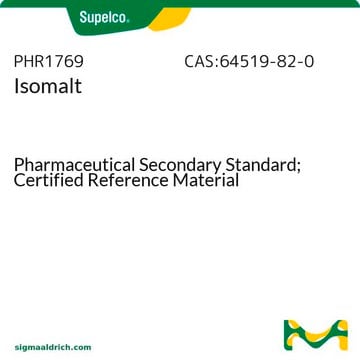推薦產品
特點和優勢
1H 线形
數量
3 mm 外径管含有 0.235 mL。
訊號詞
Danger
危險分類
Acute Tox. 3 Inhalation - Acute Tox. 4 Oral - Carc. 2 - Eye Irrit. 2 - Repr. 2 - Skin Irrit. 2 - STOT RE 1 Oral - STOT SE 3
標靶器官
Central nervous system, Liver,Kidney
儲存類別代碼
6.1D - Non-combustible acute toxic Cat.3 / toxic hazardous materials or hazardous materials causing chronic effects
水污染物質分類(WGK)
WGK 3
閃點(°F)
Not applicable
閃點(°C)
Not applicable
個人防護裝備
Eyeshields, Faceshields, Gloves
Matteo Serino et al.
PloS one, 6(6), e21184-e21184 (2011-06-24)
Daily variations in lipid concentrations in both gut lumen and blood are detected by specific sensors located in the gastrointestinal tract and in specialized central areas. Deregulation of the lipid sensors could be partly involved in the dysfunction of glucose
Ilaria Massarelli et al.
European journal of medicinal chemistry, 44(9), 3658-3664 (2009-03-11)
A dataset comprising 55 chemicals with hepatocarcinogenic potency indices was collected from the Carcinogenic Potency Database with the aim of developing QSAR models enabling prediction of the above unwanted property for New Chemical Entities. The dataset was rationally split into
Dennis J Pelletier et al.
Journal of chemical information and modeling, 47(3), 1196-1205 (2007-04-13)
The identification of phospholipidosis (PPL) during preclinical testing in animals is a recognized problem in the pharmaceutical industry. Depending on the intended indication and dosing regimen, PPL can delay or stop development of a compound in the drug discovery process.
A Guerra et al.
European journal of medicinal chemistry, 45(3), 930-940 (2009-12-22)
A neural model based on a numerical molecular representation using CODES program to predict oral absorption of any structure is described. This model predicts both high and low-absorbed compounds with a global accuracy level of 74%. CODES/ANN methodology shows promising
Sean Ekins et al.
Drug metabolism and disposition: the biological fate of chemicals, 38(12), 2302-2308 (2010-09-17)
Drug-induced liver injury (DILI) is one of the most important reasons for drug development failure at both preapproval and postapproval stages. There has been increased interest in developing predictive in vivo, in vitro, and in silico models to identify compounds
我們的科學家團隊在所有研究領域都有豐富的經驗,包括生命科學、材料科學、化學合成、色譜、分析等.
聯絡技術服務







